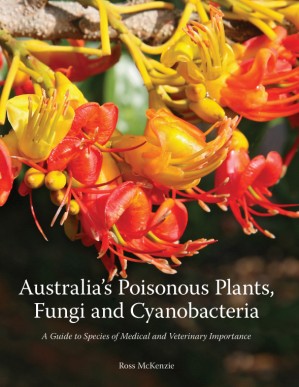by Ross McKenzie
Review by Gail Thomas
 This impressive 976 page tome written in a straight forward accessible format is an invaluable tool for a wide range of people from farmers and graziers, horticulturalists and natural resource managers to landscape architects, agricultural advisers and consultants, veterinarians and horse owners as well as poisons information centres, hospital emergency departments and medical practitioners.
This impressive 976 page tome written in a straight forward accessible format is an invaluable tool for a wide range of people from farmers and graziers, horticulturalists and natural resource managers to landscape architects, agricultural advisers and consultants, veterinarians and horse owners as well as poisons information centres, hospital emergency departments and medical practitioners.
Diligently researched and written by Ross McKenzie, retired veterinary pathologist, toxicologist and research scientist from the Queensland Department of Primary Industries where he diagnosed and researched diseases of livestock for 36 years (1973-2009).
Ross has been honoured with numerous awards throughout his career, has authored over 100 scientific publications, has contributed to several international veterinary text and reference books and is now an Honorary Research Associate of Queensland Herbarium and of Biosecurity Queensland.
Australia’s Poisonous Plants, Fungi and Cyanobacteria is the first full-colour comprehensive guide to the major natural threats to health in Australia affecting domestic and native animals and humans – the overriding aim of the book is to prevent poisoning as there are few effective treatments available, particularly in domestic animals.
The species have been chosen because of their capacity to threaten life or damage important organs, their relative abundance or wide distribution in native and naturalized Australian flora or because of their extensive cultivation as crops, pastures or in gardens. These include flowering plants, ferns and cone-bearing plants, macrofungi, ergot fungi and cyanobacteria.
The book covers all of Australia and contains scientifically-accurate, up-to-date information on species, toxins, effects and management. The plant species are grouped by life form such as herbs, grasses and sedges, shrubs, trees and for flowering plants by flower type and colour for ease of identification.
Each entry contains the full scientific name and synonyms, common name, plant description and flowering and fruiting seasons. Also highlighted are its main distinguishing features, confusing species, distribution and habitat together with the degree of danger, weight of evidence for toxicity, toxins and toxic parts of the plant, toxic dose, the animals effected and conditions of poisoning.
Species described have colour photographs showing plants as seen in the field plus there are distribution maps and notes on confusing species, habitats, toxins, prevention and control. Symbols are used for quick reference to poisoning duration and available ways of managing poisoning. A Digest gives brief details for all poisonous species in Australia together with highlighting poisonous hot spots, the top killers, Australian states with major poisonous species and a comprehensive glossary.
This is an extensive and important reference which will make a significant contribution to a broad range of professions from those associated or working on the land to medical and veterinary authorities.
Buy it from an independent bookshop, borrow it from a library or buy a copy online at the CSIRO website
by Ross McKenzie, CSIRO Publishing, $195
